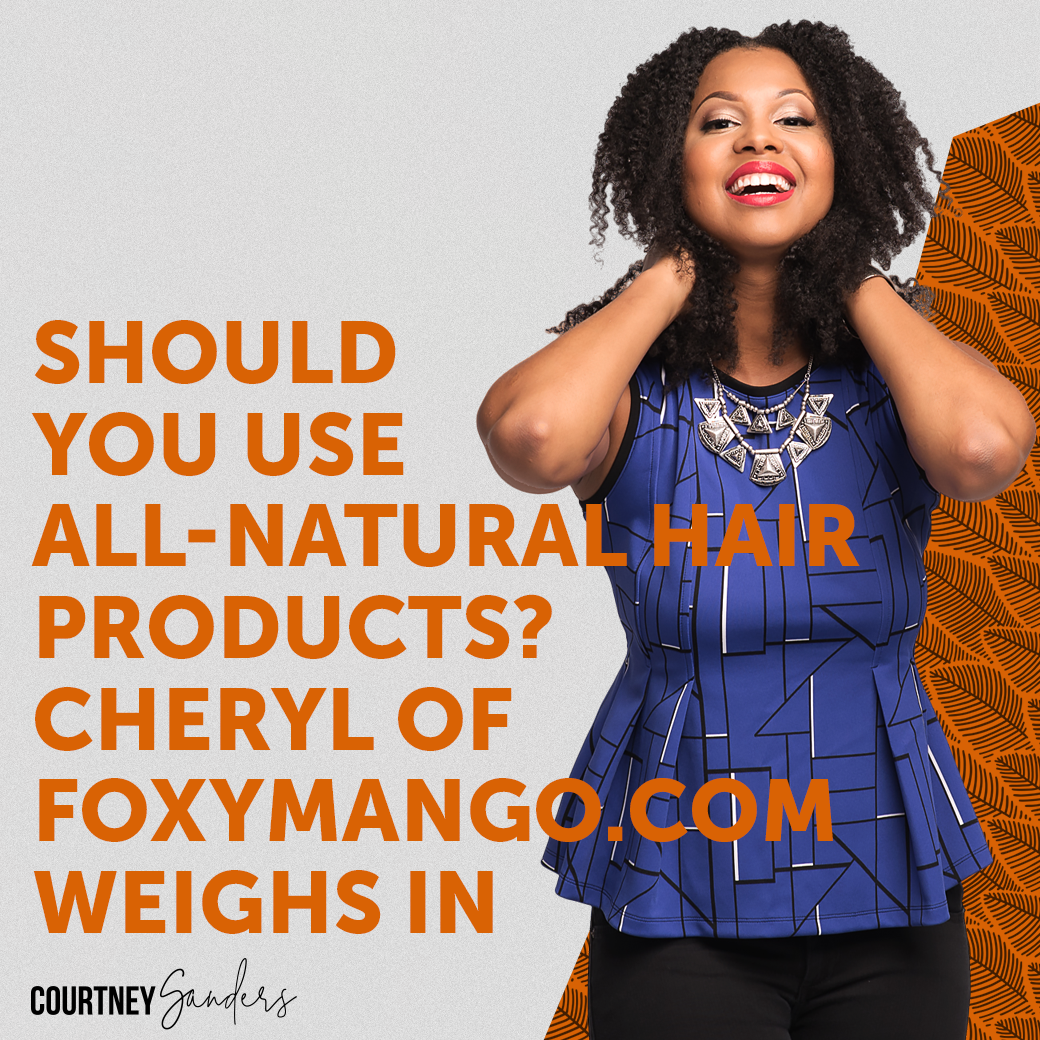

Years ago, I wrote a post called Should Naturals...well, Go Natural? that explored whether or not women forgoing perms to wear their natural hair texture should also forgo traditional, chemical-laden hair products in lieu of all-natural ones.Back then, my conclusion was that all-natural hair products were generally worth it...but I still liked a few traditional, commercial products (*cough cough* eco-styler gel...) and I wasn't quite ready to give them up!Fast forward to today and lately, I've been reconsidering. I've been working on overhauling my diet as I've learned more about the dangerous chemicals found in virtually all processed food. This has me thinking: if what you put in your body radically affects your health, maybe what you put on your body does too...Lucky for me, I've recently connected with Cheryl, owner of foxymango.com, an online retailer of all-natural hair and skin products. Cheryl is a sweet, thoughtful lady with a lot of knowledge about safe and natural personal care product ingredients. I asked her to weigh in on the safety and "natural-ness" of common natural hair product ingredients and she did!In fact, not only did she share all her knowledge about this topic but she is also offering 10% off from anything in her store (including the Soultanicals line -- love that brand, they are a MUST buy) to all Think and Grow Chick readers! Just use this code: TGC10.And without further ado, let's see what Cheryl has to say about natural product ingredients and whether YOU should be using them:

What inspired you to start FoxyMango?
I have mixed-ethnicity, mixed-textured, curly/coily/frizzy hair that had been “managed” by chemical relaxers since I was a teenager. In my 30s, I started noticing my hair was thinning, especially around the edges, I was having a lot of breakage, and my hair was consistently dry. I decided to stop relaxing to see if that was the culprit and it definitely helped. I still wore my hair straight through blow-drying and flat ironing but I started to see little ‘sprouts’ of new hair growing back at my temples and my hair was breaking a lot less.The next step was trying different products to see if I could improve the overall health of my hair even more. I’d already been working to better my eating habits – cooking at home more, less processed food and sweets, more organic items, etc. So, it followed that I started being more conscious of what products I used on my body as well. However, I found my search for more natural and safer hair care products to be no easy task. It’s hard enough to find a good selection of products that work well on curly, bi-racial hair as it is but then to also want safe ingredient products? It seemed as though I was asking too much of my local Target or Sally’s Beauty. I started looking for brands online and paying one shipping charge here, and one shipping charge over there. All the while, what I really wanted was a store that offered a variety of brands I could try, intended for curly, wonderfully crazy hair, all in one place. I wanted convenience, I wanted affordable products, and I wanted products that worked. I couldn’t find an online shop like that, so my husband and I started our own – and that’s how FoxyMango was born.I’ve been using natural and safe-ingredient products on my hair and skin for well over a year at this point, and all my thinning hair areas have filled back in, my natural curl pattern is back in a way I’ve never seen before and I can now wear my hair curly or straight, and my skin looks better than it has a long time and is healing wonderfully from many years of adult acne and scarring.

What's your personal philosophy when choosing natural hair care products?
I know not every product will work for everyone but my overall goal – for myself and for our customers – is to find products that will give textured hair the pampering that it needs without the trade-off of using potentially harmful ingredients. There are wonderful product makers out there who believe the same thing and I try to track them down and bring all these ‘healthful’ brands together in one convenient shop for people to enjoy.It also seems that the industry sometimes makes it hard for people to buy products that are healthier by pricing natural products so high as to be unaffordable. But I believe that shouldn’t be the way – it shouldn’t be a hurdle to get safer products. So I work hard to find and partner with makers who have affordable products that work. I want to bust the myth that natural products have to be expensive to be fabulous, because it’s simply not true.
What ingredients do you avoid and why?
The list of avoidables is long. I’m no science major but I would like our shop to offer products that are the most helpful, and least harmful to people and the environment. Since I’m not an ingredient expert, when I am considering a new product I use a variety of databases to research ingredients and see what is said about them. I’ll use information from resources such as Environmental Working Group’s Skin Deep® Database, Whole Foods Market’s Unacceptable Ingredient List, California’s Prop 65 Chemical List, as well as the European COSIING database of banned cosmetics ingredients since European standards are much more strict than American ones.It can be a tough task because there are many times there is conflicting information on whether something is suspected to be harmful to people or the environment, or not. If I see a number studies or articles that express concern over an ingredient, I steer clear of it. Phenoxyethanol is a great example of this. It’s used in many products that are intended to be more natural in their composition, and it has been a widespread replacement for parabens in beauty care products. When we initially launched the shop, we carried a couple of brands that had products with phenoxyethanol in them. As I continued to do research, there were articles that said phenoxyethanol is ok but I also came across several that express concern over its long-term use effects. Which ingredients are ok for someone to use is a personal choice but for our shop, I have chosen not to support phenoxyethanol and a long while back, we phased out all products containing it because I’d rather err on the side of caution. Our goal is to bring customers hand-selected, affordable goodies that they can trust - in performance and ingredients.
What are some of the potential harmful effects of these "questionable" ingredients? Why, ultimately, are they worth avoiding?
I read of effects on the body that range from skin irritation and allergic reactions to ingredients that are suspected carcinogens. For the environment, some of the substances that get rinsed down the drain can be harmful to aquatic life, waterways, and the soil.At the end of the day, everyone has to choose for themselves but for me, the point is this – there’s enough “junk” in the environment, in products, and on my meal plate, that I can’t control and that might be harmful to my health with collective and long-term exposure. Why add to the risk with items I can control such as personal care products? There are wonderful, effective, and affordable products out there that are helpful - not harmful - and so I feel like it’s only to my benefit to decide to use them.
Why do you think it is so difficult to find products specifically for textured hair with safe ingredients?
Excellent question! And I don’t know. Haha! :-) It has always been difficult to locate really good products for textured hair, period – at least in my experience. The textured hair section in most mass retailers is always this little sad area with two shelves of “options” (or lack thereof). When I started FoxyMango, I began discovering small brands that were fabulous but not available at mass retailers, and my eyes were opened to the world of possibilities I never knew about! Previously I had just settled for whatever was on the shelf in front of me at the store. What an injustice I was doing to my skin and hair, without even realizing it!Now, some of that seems to be changing as mass retailers turn more attention to catering to textured hair. So that’s hurdle #1, I guess – getting easy access to more textured hair options. Perhaps hurdle #2 will be getting easier access tosafe-ingredient textured hair care. Since I don’t want to hold my breath that long, FoxyMango is my way of providing a convenient place to find healthy hair and skin products, plus support small makers who have wonderful products that I would never have discovered otherwise!
You mentioned that natural and safe-ingredient products perform better on your hair and skin than traditional products. Why do you think your hair and skin has responded so well?
My guess (and belief) is that natural, organic, and safe-ingredient products are designed to work in concert with your body, not in conflict with it. When I’m using my Shea Terra Rose Hip Black Soap facial wash for example, it is designed to nourish my skin and keep it healthy so it can do a better job of naturally healing itself. This is in contrast to buying something that has ingredients designed to “fight” certain problem areas that may conflict with how my skin naturally behaves, which in turn, creates a new host of problems. Previous to switching my products, I would use something that would fight acne but then I’d have terribly dry skin and terrible acne scars that never went away. Since using more natural products, I’ve found I don’t have to trade-off one problem for another, and I find one product can provide multiple benefits for my skin and so I don’t have to buy as many products to keep my skin and hair happy.
Are these positive benefits something the average consumer can expect if they switch to more natural products?
Absolutely! I’m not an ingredient expert myself. I’m just some lady who wanted to find better, more convenient, healthier products, that I could afford. I would see $150 bottles of facial serum from Tata Harper for instance, and think, “I’m sure that’s absolutely lovely but where are the products for people who don’t have, or don’t want to spend, $150 on a 2 oz. bottle of serum? I didn’t want to believe that happy, healthy skin and hair was reserved only for those who have hundreds to spare. And guess what? It’s not. There are products out there that cover the spectrum of costs that can work wonders. At FoxyMango, we choose to focus on fabulous items under $35. As with anything, you just have to find the right natural products for you.So I believe I’m very much the “average consumer” and switching products is definitely something I’m glad I did. Plus, we see many wonderful reviews of FoxyMango shoppers who have switched some of their products and the success they’ve enjoyed.
For someone who is interested in but new to using natural and safe-ingredient products, what can they do to get started? Do you have any recommended resources?
First step is simply to be interested in finding out what may or may not be beneficial in the ingredients in the products you use frequently. I don’t say this so people can scare themselves with what they might find. I just feel that being curious and truly interested is a good beginning. It can get overwhelming, and you might feel like you have to become a mad scientist to figure out what might be harmful and what might not, but take heart! You’ll eventually find a good balance of ingredients you prefer to avoid, along with brands and shops that make or sell products you love and trust. As the saying goes, “when you know better, you do better.”There are a number of beauty bloggers that focus on ‘green beauty’ and have helpful “ingredients to avoid lists” to get you started. Just a couple of examples are Organic Beauty Talk (http://www.organicbeautytalk.com/ingredients-to-avoid/) and Glamorganic Goddess (http://www.glamorganicgoddess.com/pretty-toxic-ingredients-to-avoid/). Additionally, a couple of user-friendly ingredient databases I use frequently are the Environmental Working Group’s SkinDeep™ database (http://www.ewg.org/skindeep/) and Bubble & Bee’s Chemical of the Day (http://chemicaloftheday.squarespace.com/). I would say any of these resources would be good places to start when looking for a product shopping check point.
***
Thank you Cheryl for taking the time out to answer all these questions! And remember, use code "TGC10" (without the quotations) to get 10% off your next purchase at FoxyMango.com. The code is only good for a short time so if there is a product you are eyeing (like Soultanicals...just saying...), be sure to snap it up soon!
Discussion:
So what do you think? Are you making the switch to all-natural products? Or are you still unconvinced? Share your opinion in the comments.
(Top photo by Remy, the Quill. All other photos provided by FoxyMango.com)









.png)

